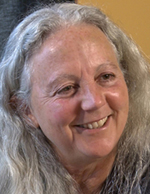The Green Interview:
Silver Donald Cameron Speaks With Alexandra Morton
~ Why Salmon Are Sacred ~
A journalist once described Alexandra Morton as the “citizen scientist who overcame intimidation by bureaucrats, indifference from government scientists, and dismissals from industry to force the plight of wild salmon to the top of British Columbia’s political agenda.”

Silver Donald Cameron |
Initially a supporter of open net-cage aquaculture in British Columbia’s pristine coastal waters, Alex Morton came to believe that fish farms on the migratory routes of wild salmon were actually causing the collapse of the wild salmon stocks. Writing letters and petitions, doing original scientific research, appearing before the Cohen Inquiry, and leading mass protests, she has generated an intense debate about the future of the iconic fish of the Pacific Northwest.
Silver Donald Cameron:
You’ve got a wonderful comment to the effect that the wild salmon are the essential power cord that carries the energy up and down the coastline. Can we just talk about that a little bit? I think that’s a fabulously interesting and important concept.
Alexandra Morton:
Yes, so when I first came out to the archipelago, I really didn’t notice the salmon. But gradually, I began to see that everything was happening around them—the whales, the humans, the culture that had developed there—and I began to really look at them. The moment the egg leaves the mother’s body, it begins to feed the world around it. Trout and these little birds that run underwater called the water ouzels eat them. Then the little fish go to sea, and the mergansers are having their babies, the kingfishers are having their babies, and the young coho and chinook, which are much bigger, feed voraciously on these swarms of beautiful little pink and chum salmon that come out of the rivers.
Then they go to sea and they basically collect the energy of sunlight hitting the open ocean. When the sunlight hits the open ocean, plankton blooms start — good blooms — and then fish eat those, and then the salmon eat those. So they collect up all that energy and they come back to this coast on a schedule to the exact place they were spawned. So now all of these other organisms have set their clock to them.
Cameron:
And so the farmed salmon really intrude on this whole bloodstream kind of thing, right?

Alexandra Morton |
Morton:
They do. The basic problem with farmed salmon is they break the natural laws. In Nature, the wild salmon is always moving, so the waste never collects, and pathogens have a lot of trouble jumping fish to fish because they’re constantly moving. And any salmon that’s a little bit slow or a little bit wobbly on the edge of the school, there’s a predator that takes it out. At every age, class, and size, there are always predators trimming up these schools, and so you don’t get epidemics.
Then there’s this other really amazing thing that happens. All the Pacific salmon that come back to the rivers, these are fish that have gone out to sea, they have fed successfully, they have found their river again, they have found the exact patch of gravel where they were spawned, and when they’re done spawning, they die. You’d think Nature would say, “Hey, go out there and do it again,” but not so. In considering this, biologists suspect that this breaks the cycle of disease.
So then you take a salmon farm. The wild fish come by and they infect the farm fish. That’s definitely part of the dynamic: sea lice, viruses, bacteria. The wild fish go into the rivers; they die. The farm fish, everybody is pressed together, and so the pathogens are having a heyday. They’re jumping fish to fish to fish, and now they’re competing against each other, so it increases virulence.
Then spring comes, and the little salmon come out of the river. We learned at the Cohen Inquiry that sixty billion viral particles can come out per hour from a fish farm with a disease problem. So they’re just coming out naked into this and they’re not surviving it.
Cameron:
Is it fair to say that industrial aquaculture, like industrial agriculture, creates unbelievably dense quantities of waste and also provides a really wonderful feeding ground for all these undesirable characters?
Morton:
Yes. So viruses, bacteria, parasites, you do not want to underestimate them. I call them the “little guys,” and salmon farms are the best thing that happened to them since the glaciers receded here 10,000 years ago.
To see this full one-hour interview (in video, audio or transcript), go to www.TheGreenInterview.com and sign up for a free one-week subscription. The site offers more than sixty in-depth interviews with environmental giants from around the world. Silver Donald Cameron, host and executive producer at The Green Interview, is one of Canada’s most respected authors and broadcasters. The Living Beach, his classic book on the ecology of shorelines, has just been re-issued by Red Deer Press.
You can also read an article by Alexandra Morton published in Natural Life Magazine in 1997 here. This article was published in Natural Life Magazine in 2014.
|

